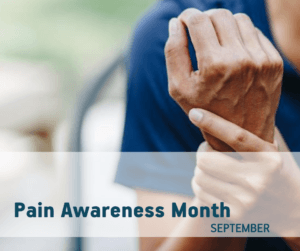5 ways to participate in Pain Awareness Month
September 1, 2020

The American Chronic Pain Association (ACPA) started Pain Awareness Month in 2001. Those of us at Southside Pain Specialists hope to help achieve the goal of raising awareness about chronic pain and chronic pain management. We will join the ACPA and other organizations in working toward these three main goals:
- Create a greater understanding of chronic pain among healthcare providers, patients, and the community
- Reduce the stigma associated with chronic pain
- Break down the barriers to effective pain management
Getting involved in Pain Awareness Month
The key to raising awareness is to get involved. There are many things that you can do to help promote Pain Awareness Month, and how to participate will be a personal decision for each of us. Whether you act in a more quiet way or broadcast your thoughts loudly, every little action counts.
These five action items can help in achieving all three goals of Pain Awareness Month:
- Show up on social media. Be sure you like and are following the ACPA Facebook page. They will post updates throughout the month there, which will be great content for you to share. These updates from them can be a starting point for you in sharing your story related to chronic pain as well. Look for and use hashtags #PainAwarenessMonth and #USPain. You can also find great information to share on social media on the Southside Pain Specialists blog.
- Share your story. Sharing your story can take on many forms. Maybe you share an ACPA Facebook post and add personal information about your struggles. Maybe you make your own updates throughout the month. You can also share our Facebook or Twitter posts and add your own thoughts. Part of reducing the stigma surrounding chronic pain is letting people know that chronic pain can happen to anyone. You haven’t done anything wrong if you experience chronic pain, and you should not be ashamed. When you open up about your struggles, you will likely find that others have similar stories to share as well.
- Open up to friends and family. For some, sharing personal information on social media is uncomfortable. A smaller-scale approach may be a better fit. Make sure the people you are closest to know that you suffer from chronic pain. Talk to them about what you are facing, what you are doing about it, and what you need. You may find that they want to help, and there are so many ways in which they can do so. A ride to the doctor, grocery store pick-ups, texts of encouragement, and learning about chronic pain are just some of the ways they can possibly support you, but they must know what you need first.
- Communicate with your doctors. Good communication is vital to getting the help you need to live well in spite of your pain. Even if we have your pain under control, make an appointment with us this month to check on how things are going. There may be things we can do to be more proactive in your treatment.
- Take care of yourself. Self-care is always hugely important when you are living with chronic pain. If you haven’t found the acts of self-care that are most important to you, vow to do so this month. If you know what types of activities improve your daily life, make sure you are regularly practicing those things each day.
By taking action on these five items — during Pain Awareness Month and all year long — we can all work together to create a greater understanding of chronic pain, eliminate stigmas, and break down barriers to treatment.
